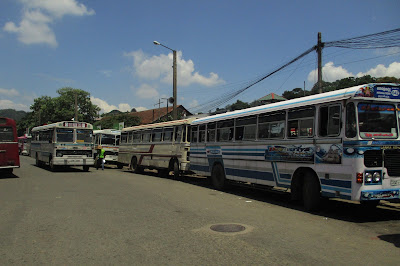We
started from Kaduruwela at 7am to Kandy by a private bus (LKR 200, 5hrs) going
through Habarana-Dambulla-Matale. This was stopping at every 2km and was
crowded most of time. You can get down at Dambulla and ride an air-con bus to
Kandy. The commercial capital of Sri Lanka didn't impress us much so we didn't
stay at Kandy. The next bus from Kandy to Nuawara Eliya (LKR230, 3hrs) was
faster air-con bus going through Peradeniya-Pussellawa. Train takes a different
route. We met Ravindu who works at Commercial Bank owns Toyota Prius for rent.
Kandy to Bandaranaike airport LKR 6000. You can rent this car without drive for
LKR8000 per day.
Accommodation
at NuwaraEliya is the highest in entire Sri Lanka, thanks for its importance as
a tourist location. At an elevation of 1989m, the erstwhile colonial remnants
are well maintained at this hill station. Victoria Park Inn, behind Victoria
Park offers basic rooms(LKR 2500, Tel: 222 2321, 0776607108) is the cheapest
deal we could find. They can arrange mountain bikes for LKR1500 per day and
runs tours to Next door New Tour Inn (LKR4000, heater LKR800 extra. Tel 52
2234897, 522223182) is a better option. Ambal's veg restaurant in the main town
is the best option fo vegetarian local food.
Walking
around the town, you can visit the colonial-era post office, Victoria park.
Gregory park on the way to Nanu-Oya railway station is a major attraction. The
super-slow goods train to Ella leaves from Nanu-Oya at 9:25am (4hrs, LKR110),
just hop on and grab a seat. This train delivers diesel to the tea-factories on
the way. Enjoying the misty mountains, tea-estates and drizzle, we reached Ella
at 1:45pm.
Ella is
tourism on steroids; 100 local families and 500 tourists. At walkable distance
from the railway station, you can find guest houses and restaurants on both
sides of the road. Dollar-friendly prices and menus, difficult to find a small
restaurant. A juice costs LKR 350. We stayed at Soorya Guest Inn (dbl LKR2000,
Tel 077 03515662, 0094 572228906)for four nights. Owner Dasith Warnasooriya and
manager Gamini were really helpful.
Ella Rock
is a must-do walk at Ella and there are many trails leading to this nice place.
The easiest is to walk along the railway track towards a tiny railway station
Killadella crossing a black bridge. Then turn left to a tea plantation and
cross a small stream to walk up the hill. On the way you will find a tea-shop
selling tender coconuts and tea. Two policemen were whiling away there,
supposedly on Ella Rock Duty. One of them started asking questions non-stop.
Name, Country, Marital-Status, Salary, Children and so on…he had a train of
unrelenting questions. I am not sure why the policemen are so damned irritating
and questions me like an accused. You will get a nice cup of hot tea on the top of the hill though a tad expensive at LKR100. Gawking at the scenic view of Ella,
we spent 30min over there before walking to another view point looking over
Ravana waterfalls.
Little
Adam's Peak is a short walk from the main road and you get a panoramic view the
hills and road to Badulla. Ask anyone on Passanda road for the direction and
they will guide you, at least pointing their hands on the right direction.
There is a deviation near the flower garden. One way might take a little less
than 1hr from Ella Gap Hotel. You can visit Nine Arch Bridge on your way back
which is a British engineering marvel. We didn't walk on the track to return to
Ella Railway station, which many locals do and recommend. Walking on the
railway track is illegal and there will be warning signs not to venture into
this.



























